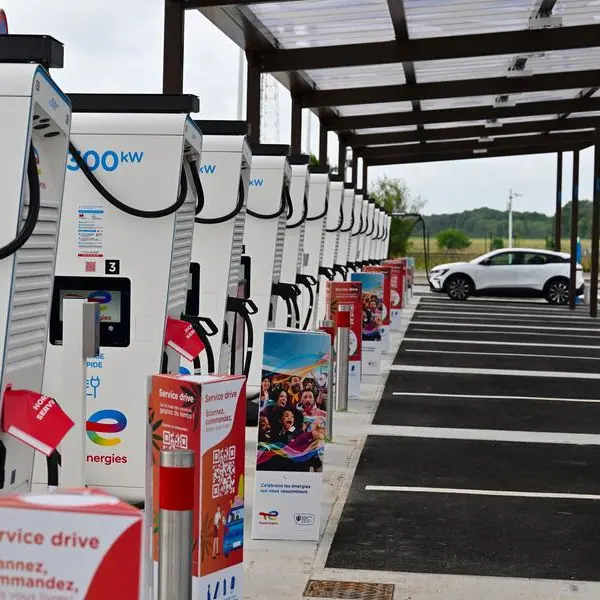PHOTO
Arab Finance sat down with Mahmoud to discuss the company’s strategy, its extensive marketing efforts, and share some interesting facts about the furniture market.
Can we start by explaining to our readers how and when you launched Homzmart?
I started my career at Cisco at the beginning of the rise of the .com era in the region. Seeing this boom, I joined the early founding team of Jumia, where I was VP Operations, and then I moved to co-found an e-commerce company called Daraz in South Asia, namely Pakistan, Bangladesh, Sri Lanka, and Myanmar. This became the biggest e-commerce website in South Asia, excluding India, and eventually got acquired by Alibaba, which was a good experience to understand more about the Chinese ecosystem.
The more I got into this, the whole e-commerce business, the more opportunities became apparent in the Middle East, and eventually, it was time to come back and kickstart something in an industry where I believed there was a big gap in the market, which is the furniture and home and living category.
We noticed there were so many startups focused on food, payments, ride-hailing, transportation, logistics, etcetera, but no one was really focusing on the furniture business, even though it is a very big market. The furniture business was around $100 billion just in our market, without the likes of the US’s Wayfair or India’s Pepperfry or Brazil’s MadeiraMadeira.
So, it was about time to take off, and I think the whole idea came from there. We kicked off the business, and we’ve just been expanding significantly, growing around 30x just in the first year. So, we believe we can actually see appetite from a demand and supply side, and we’re really glad to see Homzmart is filling that gap.
What sets you apart from other furniture outlets? Why online and not a brick-and-mortar store? How are you able to compete with big names in the business such as Ikea in terms of pricing, quantity, and quality?
I think a lot of people get confused about us competing with Ikea or some other major furniture brands, but in reality, we do not compete with them. We are a platform, an online marketplace, really, and our goal is to help them gain access to more consumers because ultimately we are a sales channel for them.
Ideally at some point Ikea, Home Center, all those guys should be on Homzmart. You can already see this trend with some of the biggest brand names in Egypt already on our platform, from Asfour Crystal to Oriental Weavers to American Furniture and Smart Furniture.
Homzmart is like an online furniture mall, with the main goal of offering convenience to users and merchants alike by offering an easy-to-access marketplace. The second is to create a specialized one-stop shop for the niche furniture market. When it comes to offline shopping, there are specialized shopping centers for fashion, food, technology, etc., but furniture seems to be fragmented where you need to go to specialized outlets. This is what Homzmart aims to capitalize on by creating a one-stop shop where all our consumer segments can find all the various furniture supply segments.
Prior to Homzmart, we’ve seen that the supply side typically faces a hard time reaching the demand side. From a supply point of view, distribution costs are very expensive. Getting a showroom along a major street or renting retail space in a mall with enough traffic is expensive, right? We’ve typically seen that 100% of the demand is catered for by only 15% to 20% of the supply because this is the supply with the necessary capital to be seen by consumers.
What Homzmart aims to do is to liberalize access to the marketplace and provide discoverability to the supply side, providing exposure to consumers who may have otherwise never seen a particular merchant or supplier. We stand in between supply and demand and facilitate the movement and the transaction in a convenient manner for both. We get quality products to end-users at price points that do not carry the extra overhead of brick-and-mortar showrooms, and again this ends up satisfying both sides of supply and demand.
Now, we work with thousands and thousands of suppliers, vendors, merchants, and other partners from the supply side.
How much capital was required to get the company up and running?
Both my co-founder Ibrahim Mohamed and I have extensive backgrounds in e-commerce, which ultimately helped pave the way to build good reputations in the industry, facilitating the process of raising cash to create a good opportunity for investors on which to capitalize.
Initially, we were able to raise $2.2 million in seed funding backed by China’s MSA Capital, Oman Technology Fund (OTF), and Equitrust, Choueiri Group’s investment arm, as well as 500 Startups, and others.
Later on, we successfully closed a $15 million Series A fundraise led by MSA Capital and Nuwa Capital, with participation from investors, including Rise Capital, Impact46, EQ2 Ventures, and Outliers Venture Capital.
Overall, we have managed to raise nearly $17.5 million for Homzmart, and this is what it keeps the whole operation growing.
How do you guarantee your furniture quality? How do you handle dissatisfied customers and/or vendors that do not meet your standards?
As a marketplace, our core mission is to connect supply and demand using sophisticated and advanced technologies to control costs as much as we can. So, the company is managed via quite a sophisticated scorecard based on consumer feedback. This is how each seller gets an opportunity to become more exposed than others.
Based on a lot of data-driven consumer behaviors, this drives which customers see which suppliers at what time.
That said, there are of course the outliers, as is the case on any e-commerce platform regardless of the niche or products being sold, and in those instances, we take quite an aggressive stance by either delisting them if they keep receiving repeated negative feedback. But before we get to that point, first we educate, we train, and then we try again.
Back in May or June, we, unfortunately, had to delist nearly 200 sellers from our platform because ultimately our goal to ensure our marketplace has vendors that our clients and customers are satisfied with, that deliver good quality products and prices our customers find acceptable.
Your advertising/marketing efforts are impressive (I see your ads everyone on my own social media channels). Can you talk to us about your online marketing strategy?
Our entire online marketing strategy is based on data analytics. We are able to work with our digital marketing team to identify our target audience to determine what to advertise and when based on the likelihood that these are potential customers who may be looking to buy furniture or home decorations. Our digital marketing team works of course with all the major online advertising platforms to deliver ads based on keywords.
Our data can also drive a lot of logic-based advertising. So, if you bought a sofa from us, maybe you then need a coffee table. We can focus our marketing efforts to advertise this somewhere within a relevant time period. We play around with things like that. This is something in which we invest a lot of time, effort, and funds to better understand our consumer behaviors and ultimate we react to this in terms of our marketing strategy.
Do you focus on advertising or marketing other than online? Do you do any print advertising or TV commercials or anything like that?
For TV commercials, this was never something we actively pursued, but we have done things in partnership with others that do, such as our partnership with Vodafone during their last Vodafone Cash campaign.
As for offline marketing efforts in general, yes, this is something we do. During our anniversary, for example, we were all over the street on billboards around the country.
We have been fortunate enough to introduce something to the market that no one has done before, but that also means that there really isn’t a clear handbook for it. This gives us an opportunity to experiment and try different things to gauge and benchmark effectiveness and success based on customer reaction. So far, the ROI on our trials has been quite impressive, and I believe this reflects in our growth.
How do you monetize? Can you talk to us about your margins in general?
So again, we stand between supply and demand, which means we are just like any other typical e-commerce platform, generating a margin off each sale. This margin differs, of course, from one product category to another on the platform. We sell all kinds of home goods, from furniture, to lighting, to home appliances, decorations, and of course each product category generated different margins.
How many registered users? Average number of transactions per day or week or month? How has this grown year over year since launch?
While I can’t disclose exact divs, I can tell you that we are now talking hundreds of thousands of registered users.
In terms of growth, I can tell you our company’s Q3 2021 top-line rose 3x Y-o-Y and 60% Q-o-Q.
So, you can see the growth happening not just Q-o-Q, but also each day as the number of users growth, the number of daily transactions grow, the average value per transaction grows.
We’ve reached a point now where we need to ensure our supply is growing the right way to match demand. That's why we’re exerting tremendous effort now to ensure our marketing and commercial teams coordinate the right way to ensure an equilibrium. We have a full team of data scientists dedicated to ensuring that supply and demand are matched together in the right way.
Can you share with us your average ticket size?
I can’t really disclose that, but what I can tell you is compared to a typical e-commerce platform, our average ticket size is around 20x to 30x higher.
Can you draw any conclusions from your data on consumer behavior before/during/after the COVID-19 pandemic? Did sales increase or decrease during the peak of the pandemic (prolonged at-home period)?
By the time we had our hard launch, it was already February 2020 just before the peak of the pandemic. I'm not sure if we would have performed better before or after COVID-19. We were very scared at the beginning because we didn’t know what would happen, but our business just kept growing, with that trend continuing since then.
Globally, we can see the trends, that people understood more about the essential need or the mandate to move to digital. We could see that from our supply. Before COVID, home goods and furniture outlets didn’t really have much of an online existence, but after COVID there was a huge need for everything to move online as all the brick-and-mortar stores were forced to shut down for several months.
When the pandemic became a reality, we saw hundreds of vendors rushing to join Homzmart as soon as possible, with our platform ultimately becoming the sole or the biggest sales channel for them as an alternative to what would otherwise have been zero sales without any footfall or traffic to their physical stores.
What are your top 3 expenses?
We prioritize investing in our people above all else and want to ensure they grow as the company grows. After that is our investments in our technology. Finally, we invest heavily in our marketing strategies and data analytics.
Do more of your clients pay by credit card, COD, or via installment platforms such as valU?
As far as I know, I think we're the first established or well-funded company that offers cash on delivery (COD) for furniture in the world. That said, given the prevailing consumer mindset in Egypt, especially with credit card penetration rates being so low, I don’t think we would have been able to grow the way we did if we hadn’t accepted COD from the get-go.
But part of our job is to get more consumers to trust online and e-commerce-based shopping in general, and I’m glad to say that we can certainly notice a trend with an increase in the number of prepayment methods, such as debit/credit cards.
We also see that the bigger the ticket size, the more likely our consumers may want to consider financing options, whether that be via credit cards with their banks or other consumer financing options such as valU.
So, what’s next for Homzmart?
We hold ourselves accountable for digitizing a very fragmented industry in our region and every time we see a gap in the journey between supply and demand, we try to solve it with solutions, such as the logistics services arm we just recently introduced. This is what the funds are required for, to fill the gaps that we are seeing along the way. It's phenomenal growth that we're seeing, and the more growth we see, the more we need to invest in the gaps that become apparent along the way. We are not quite yet a very integral platform, but I am sure we will be one day very soon, and we're working hard on this.
Additionally, one of the main reasons for the funding we raised is to expand regionally, and I think that could happy very soon.
Copyright © 2021 Arab Finance Brokerage Company All rights reserved. Provided by SyndiGate Media Inc. (Syndigate.info).












